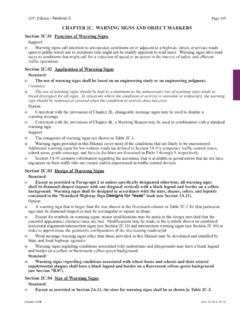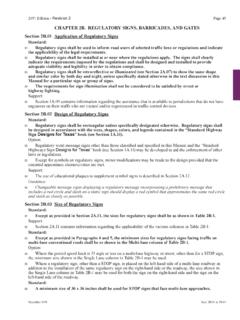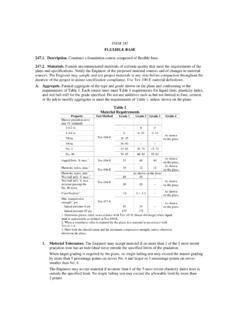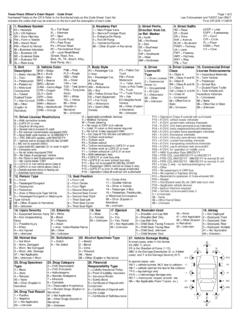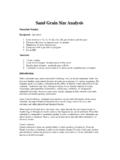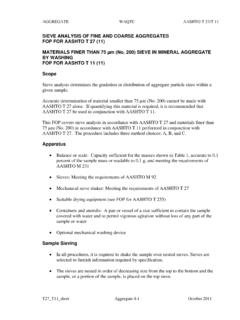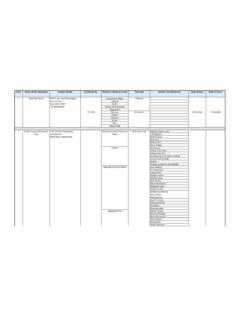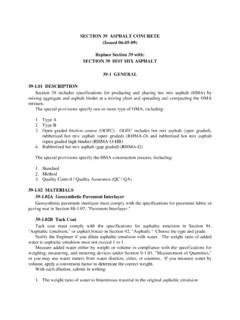Transcription of Sieve Analysis of Fine and Coarse Aggregates
1 Sieve Analysis OF FINE AND Coarse Aggregates TXDOT DESIGNATION: TEX-200-F. Test Procedure for Sieve Analysis OF FINE AND Coarse . Aggregates . TxDOT Designation: Tex-200-F. Effective Date: January 2016. 1. SCOPE. Use this test method to determine the particle size distribution of aggregate samples, using standard sieves with square openings. Use Part I to determine a weight-based, dry- Sieve Analysis for an aggregate sample. Use Part II to determine a weight-based, Sieve Analysis for an aggregate sample requiring a washed Sieve Analysis . Use Part III to determine a volume-based, Sieve Analysis for an aggregate sample. Perform a volumetric Sieve Analysis when Aggregates with differences in bulk specific gravity greater than are blended. The values given in parentheses (if provided) are not standard and may not be exact mathematical conversions.
2 Use each system of units separately. Combining values from the two systems may result in nonconformance with the standard. 2. APPARATUS. Sample splitter, quartering machine, quartering cloth, or shovel and a smooth surface. Set of standard U. S. sieves, meeting the requirements of Tex-907-K. Mechanical Sieve shaker. Balance, Class G2 in accordance with Tex-901-K, minimum capacity of 10,000 g. Drying oven, capable of attaining a temperature of at least 200 9 F (93 5 C). Various pans. Scoop. Brass wire brush. Bristle brush. CONSTRUCTION DIVISION 1 10 EFFECTIVE DATE: JANUARY 2016. Sieve Analysis OF FINE AND Coarse Aggregates TXDOT DESIGNATION: TEX-200-F. 3. PREPARING MATERIAL SAMPLE. Follow this method to prepare aggregate that has been sampled from a stockpile. Note 1 This sample preparation method is not applicable when performing a Sieve Analysis on material obtained from an ignition oven or extraction sample.
3 Place a representative sample of processed aggregate in oven and dry to constant weight at a minimum temperature of 200 9 F (93 5 C). For field testing of portland cement concrete aggregate, it is not necessary to completely dry, but merely to surface dry, the Coarse aggregate. Dry limestone rock asphalt (LRA) samples at 140 9 F (60 5 C). Note 2 For control testing, particularly where rapid results are desired, it is generally not necessary to dry LRA aggregate. For Coarse materials (major portion retained on the No. 8 [ mm] Sieve ), quarter the sample to the required size as shown in Table 1 using one of the following methods: sample splitter, quartering cloth, quartering machine, or mix on a smooth clean surface with a large flat scoop or shovel until blended, and quarter with a straight edge. For fine materials (major portion passing No.)
4 8 [ mm] Sieve ) thoroughly blend sample and take small portions from several places in the pan to make up a test sample with the required size as shown in Table 1. For control testing, create the test sample for all size Aggregates by blending small portions taken from several places in the pan. For plant control testing, weigh Aggregates in the same proportions as used in the bituminous mixture being produced, then combine and Sieve to yield the combined aggregate gradation. Reverse Sections when this proves more practical. CONSTRUCTION DIVISION 2 10 EFFECTIVE DATE: JANUARY 2016. Sieve Analysis OF FINE AND Coarse Aggregates TXDOT DESIGNATION: TEX-200-F. Table 1 Minimum Size of Samples Nominal Maximum Minimum Weight of Field Minimum Weight of Sample Aggregate Size1 Sample, g (lb.) for Test, g (lb.). Fine Aggregate No. 8 ( mm) 4500 (10) 500 ( ).
5 No. 4 ( mm) 4500 (10) 500 ( ). Coarse Aggregate 3/8 in. ( mm) 4500 (10) 1000 (2). 1/2 in. ( mm) 4500 (10) 1500 (3). 3/4 in. ( mm) 4500 (10) 2000 (4). 1 in. ( mm) 6800 (15) 3000 (6). 1-1/2 in. ( mm) 9000 (20) 4000 (8). 1. Nominal maximum aggregate size is one Sieve size large than the first Sieve that retains more than 10% of the total aggregate. PART I DRY Sieve Analysis (BASED ON WEIGHT). 4. SCOPE. Use this procedure to determine a weight-based dry- Sieve Analysis for an aggregate sample. 5. PROCEDURE. Prepare the material sample in accordance with Section 3. Accurately weigh the total sample to the nearest g. Record this weight and designate as WT in Section 8. Place the set of sieves, with the largest opening on top, into a pan and pour the aggregate onto the top Sieve . Separate the material into a series of particle sizes using the sieves required by the material or project specifications.
6 The use a mechanical Sieve shaker is the preferred method for separating the materials into the specified sizes. If a mechanical shaker is not available, proceed to Section Establish a shaking time for different types of Aggregates that will assure proper sieving of the material without degradation. When the required mechanical shaking time is complete, hand Sieve by lateral and vertical motion of the sieves with a jarring action that keeps the material moving continuously over the surface of the sieves. CONSTRUCTION DIVISION 3 10 EFFECTIVE DATE: JANUARY 2016. Sieve Analysis OF FINE AND Coarse Aggregates TXDOT DESIGNATION: TEX-200-F. Continue hand sieving until no material passes through the Sieve . Proceed to Section If a mechanical shaker is not available, hand Sieve the entire sample. Hand Sieve by lateral and vertical motion of the sieves with a jarring action that keeps the material moving continuously over the surface of the sieves.
7 Continue hand sieving until no material passes through the Sieve . Brush particles clinging to each Sieve into the next lower Sieve with a bristle brush. Ensure no material is lost. Determine the individual weights to the nearest g of aggregate retained on each Sieve and record these weights. Place an empty pan on the scale and tare or zero out its weight. Pour the retained aggregate into the empty pan and record this weight as X1 in Section 8. Re-tare the pan for the next size Sieve or tare a new pan if required to keep the material separate. Repeat this process until the weight of the material on each Sieve and the retaining pan (typically the material passing the No. 200 Sieve ) has been recorded. Report the percentages to the nearest for each size of aggregate retained on each Sieve as set forth by the specification requirements.
8 Refer to Section 8 and Section 9. Make the original Sieve Analysis a 'total retained' Analysis by weighing the material cumulatively, placing the material retained on one Sieve directly on top of the previously weighed material from the larger size Sieve , already on the balance. Note the difference. Take care to prevent loss of material during the sieving operation. However, if there is a small discrepancy (less than ) between the original dry weight of sample and the sum of the weights of the various sizes, assume the small amount as particles passing the smallest size Sieve and use the original weight; if the discrepancy is large (greater than ), check the weights of the various sizes or rerun the Analysis with a new sample to correct the error. PART II WASHED Sieve Analysis (WHEN SPECIFIED BASED ON. WEIGHT). 6. SCOPE. Use this procedure to determine a weight-based Sieve Analysis for an aggregate sample, requiring a washed Sieve Analysis .
9 CONSTRUCTION DIVISION 4 10 EFFECTIVE DATE: JANUARY 2016. Sieve Analysis OF FINE AND Coarse Aggregates TXDOT DESIGNATION: TEX-200-F. 7. PROCEDURE. Prepare the material sample in accordance with Section 3. Note 3 Test a minimum of two samples from each stockpile when developing a mixture design in accordance with Tex-204-F. Weigh the total dry sample to the nearest g. Record the weight and designate as WT in Section 8. Place the sample in a wash pan and inundate with clean potable water. Gently mix the water into the sample with the hands to break up clay lumps or sand balls and loosen the coating of fines on the Coarse aggregate. Rinse any sample particles clinging to the hands back into the wash pan. Soak the sample a minimum of 10 minutes. A sample that contains very high clay content may require overnight soaking. Remix the sample with the hands as noted in Section and repeat Section Place a set of sieves, a No.
10 8 ( mm) and a No. 200 (75 m), in a pan or over an open sink. Flush the wetted sample over the set in small batches to prevent overloading (clogging). and damage to the No. 200 (75 m) Sieve . When the material retained on the No. 8 ( mm) Sieve is adequately washed, remove it and place in a clean drying pan. Continue to wash the material retained on the No. 200 (75 m) Sieve until the wash water runs clean. Then place it in the drying pan with the previously cleaned No. 8 ( mm). material. Continue the process until entire sample is washed over the set of sieves. After the final wash, rinse the sieves over the drying pan. After the fines have settled, decant excess water from the drying pan and dry the washed sample to a constant weight. Weigh the dried washed sample and record the weight. Designate this weight as Ww in Section 8.


